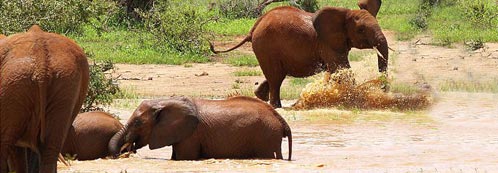Field Notes
January - April 2017
Rainfall patterns continue to change in Tsavo. This year during January and February, it was hot and rained in many areas with green vegetation and full waterholes. While in other areas, there was little rain. March was also hot, relatively dry, and several waterholes contained wet mud. In mid-April, the temperature was much cooler and windy with showers in some areas. Large flocks of storks, egrets, herons, Carmine bee-eaters and Eurasian Rollers were swooping around groups of elephants in green open grassland areas. As the vegetation dried, many elephants moved east and the flocks of birds followed.
Tsavo elephants often climb hills. During both the wet and dry season, they use zigzag paths to climb up and over the hills. This year many families and young bulls were feeding on the hill slopes. In March (photo left), a family was feeding on shrubs almost to the top of a hill. In April (photo right), an adult female was feeding at the crest of the hill with her two young offspring nearby on the other side of the boulders.
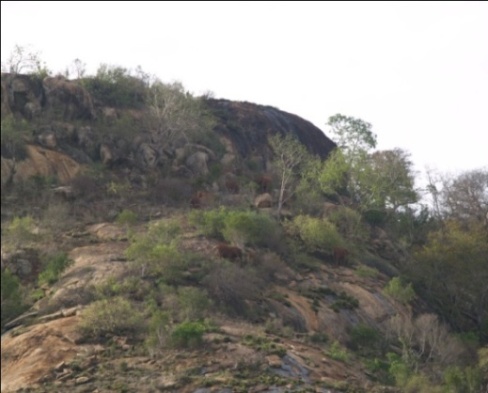
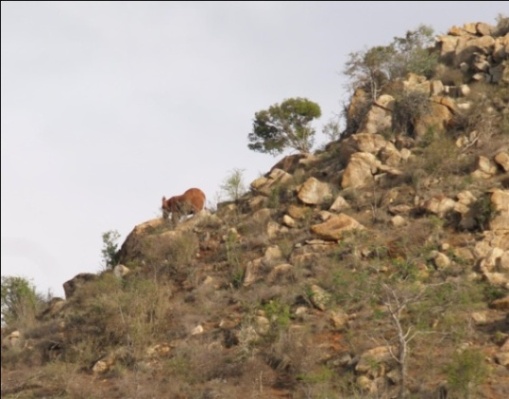
Bulls
Between January and April, many bulls moved back and forth between the southern and northern areas of the bull region: Crux, Wind, Moonlight and Pisces. In February, Solar, photo left (id-year 2010) was with Oort and four unknown young bulls in the northern area. In early-March, he was with Pisces in the southern area, first with a family resting under a Delonix, and then he and Pisces left the family heading east. In mid-March, he was back in the northern area resting in the shade of an Acacia with Moonlight.
In mid-March, Blazer, photo right (id-year 2014) was with Moonlight and Indigo’s family at a waterhole in the northern area. In early-April, he had moved to the southern area. First, he was alone in the shade pulling down a strip of Acacia bark, then a young unknown bull joined him. They spent 30 minutes together in the shade feeding on the bark then headed south.
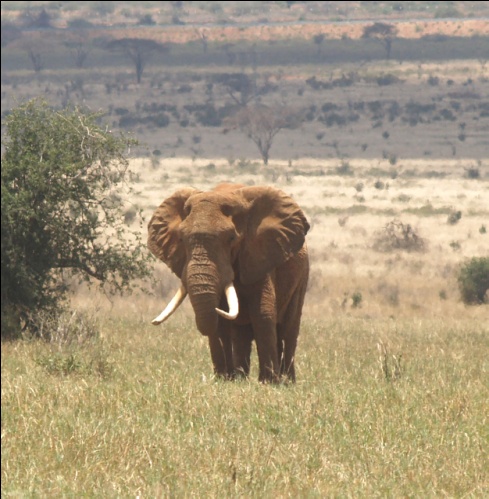
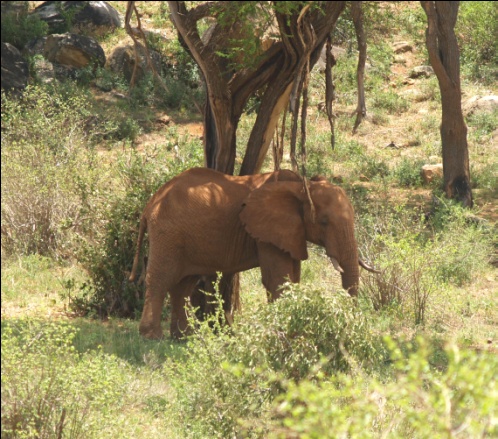
Families
Many families aggregated in green areas surrounding the hills and open grassland areas: One Tusker with Cypris, Miranda with Osiris, Lya, Savanna, Boscia, Medora, and Ambrosia. Two well-known females broke their tusks since the last sightings. Miranda broke half of her long left tusk (see photo field notes May-August 2016). Flora (id-year 1990) broke half of both her long tusks.
C.T. (photo-left) a tuskless female has a distinct crooked tail. When she was identified in 1989, she had two male offspring. Since then she has had one female and two male calves. C.T.’s family is part of the Hill clan but spends half the time near Voi Riverine. In early-April, she was with her young male calf and an unknown female with a newborn. She often associates with Gardenia, One Tusker, Cypris and Joanna’s family.
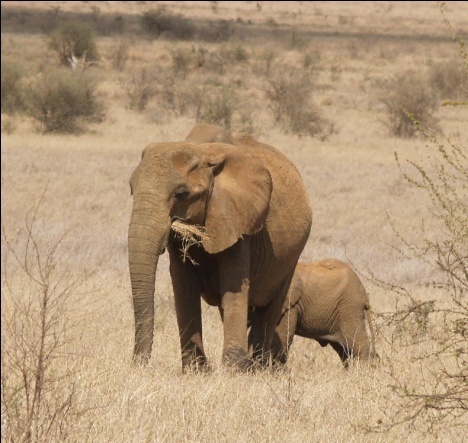

Walnut (photo-right) is a new identified female with a single right tusk. She has many holes and notches in both ears and very long tail hairs. In April, she was with her young male calf drinking from a supplemental waterhole. A short time later, a 15-year old female ran from Voi Riverine trumpeting as she joined Walnut and her calf at the waterhole. Young elephants must learn to use their trunk to drink water. Although Walnut’s calf used his trunk to drink several times, he seemed to prefer bending down to use his mouth to drink. This small family of three drank, splashed then headed south to the riverine.
May - August 2017
During May, the rains were plentiful in some areas, with green vegetation and full waterholes. June and July were cool, windy and dry months and by mid-June many waterholes contained only mud. In mid-June a flock of more than 50 Vultures, most of them first-year chicks with fluffy feathers were near a lion that had just killed a buffalo. In July, a large group of Giraffe was on the north bank of the Galana River, and down river, a family of elephants was crossing the river heading north. In August the temperature began to rise and there were showers for two-three consecutive days, sunny and dry for a few days then showers again for a couple of days; not enough to fill waterholes but in some areas the grass turned green again.
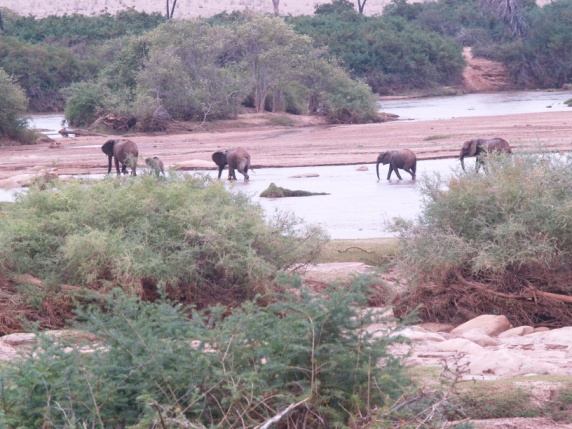
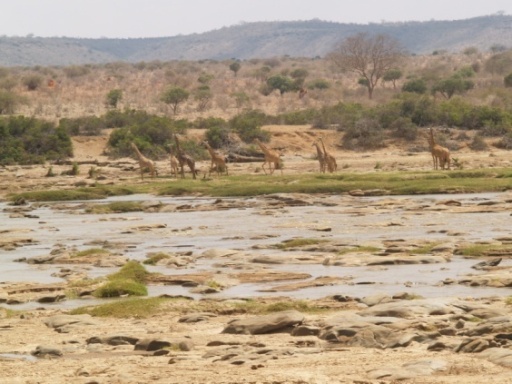
The results from the February 2017 Tsavo Ecosystem total elephant aerial count were recently published.
The survey covered 49,611 sq. km. Tsavo East and West National Parks, Chyulu, Kitui, livestock ranches, communal land and Mkomazi in Tanzania. 12,866 elephants were counted. Almost half (6,072) of all the elephants were counted within the study area of Tsavo East.
Bulls
In the bull area, bull groups were small with 2-4 bulls and most of them were young (15 years old). Several young bulls were with a family, Third, Swift and Wind. In mid-June Quark 20 years old (id-2010) was alone feeding at the base of a hill. The next day he was 8km north heading south alone then joined a family at a waterhole. In mid-July, he was in the same area feeding next to a bull the same age.
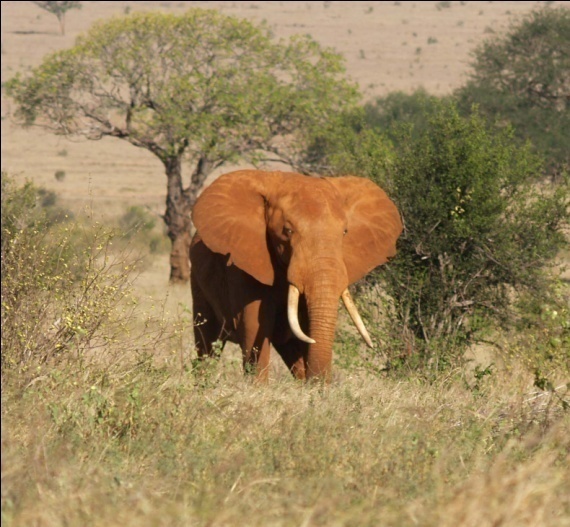
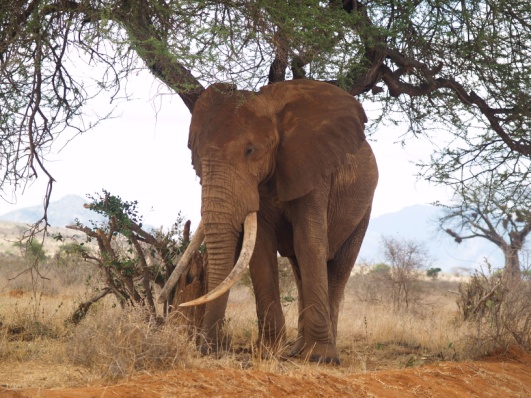
Pemba (photo-left) moved into the bull area in 2015. He is often alone. In early-May, he was headed toward a waterhole, with two young bulls (12 and 15 years old) following him. Young bulls often associate with older bulls that have knowledge about an area. In late-May, he was alone and had moved 5km northwest to a thick bush area. The next day he was alone again and had moved south 10km to an open grass area. Sunray (photo-right), identified twelve years ago, is typically with other bulls his own age or older and on occasion he is alone. In mid-July, he was with Jarvis, Crux and Skylight feeding in an open grass area. He left the group and headed toward an Acacia to rest.
Families
Between May and August, many small family units were climbing the hills and feeding on green vegetation between the rocks. In Tsavo, families often consist of one adult female and her one or two dependent calves. Savanna, one of the known hill climbing small families from the Hill Clan was feeding on the east and west base of a hill on several occasions. Her female calf born in 2014 is healthy and now has two-tusk buds.
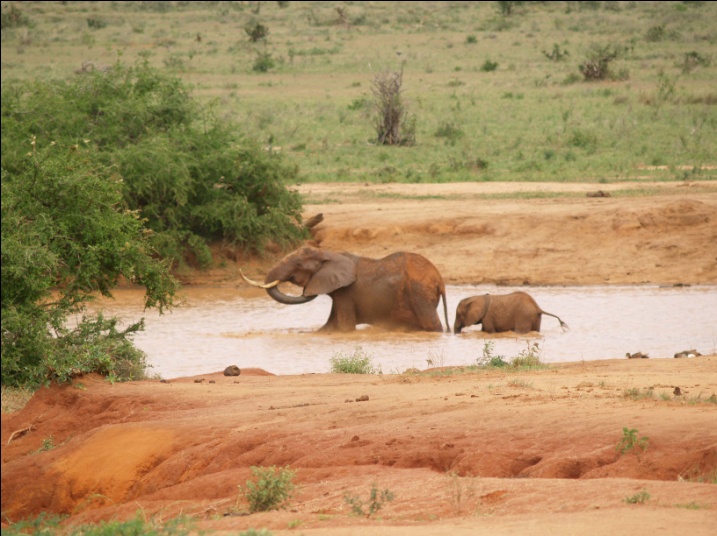
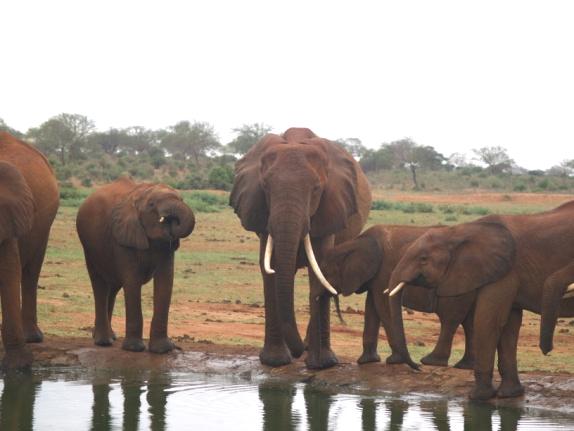
Several known families of the Hill Clan move back and forth between the hills and Voi Riverine; Heloise, Lya, Poppy, Vanilla and Ambrosia. In mid-May, Ambrosia (photo-left) was with her female calf, north of a hill heading toward a waterhole. In early-July, she was near Voi Riverine with her calf and a young 10-year old female. 16-days later, she had moved back to the hill area to a pool from a water pipeline leak. She and her calf were waiting for a dominant female and her family to move away. Crescent (photo-right) part of the Hill Clan is one of the original identified females from the mid-1990’s. She was with her male 3-year old calf and a 40-year-old unknown tuskless female in a group of six, at a waterhole near the Voi Riverine. After the family drank and splashed, they headed north, single file along an elephant trail, to a large Acacia to rest in the shade.
September - December 2017
During September, it rained for several days, not enough to fill waterholes, but within a few days the vegetation was green in some areas. In October, the grasses were dry in almost all areas, but the Acacia trees were green. Kori Bustards, photo left, are often in the bull area. Although they rarely fly, I saw several fly over the top of grasses. After an exceptionally long dry season, the rains started in early November primarily in the south and eastern regions of the park. By mid-November, rains were widespread with abundant resources and elephants aggregated in groups of more than 100 individuals. In November, migratory birds arrived in Tsavo; large flocks of Barn Swallows and Eurasian Rollers and many pairs of Steppe Eagles, photo right.
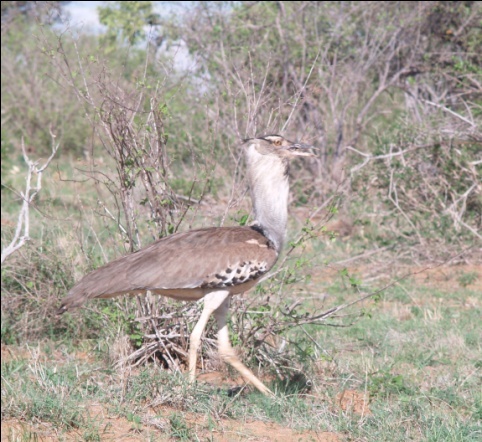
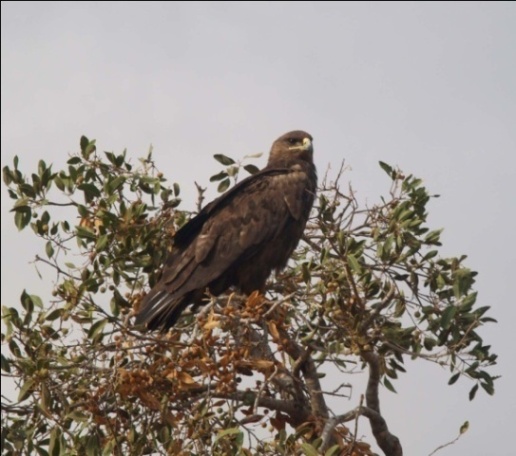
Bulls
During September and October, bull groups were small (2-4 bulls) in the bull area. Swift (15 years, id-2016) a newly independent bull often climbs a hill. In September, he was at the top of a hill with an adult female 50 meters below him. In mid-November, Third (15 years, id-2014) another newly independent bull was in the central region of Voi Riverine with an unknown 25-year-old bull. Eleven days later, he had traveled 35 kilometers northwest to the bull area. He was with another young bull (unknown, 15 years) traveling to a waterhole. When they arrived at the waterhole, they met Zero (30 years old, id-2012). The three bulls stayed together feeding then headed north to the shade of an Acacia to rest.

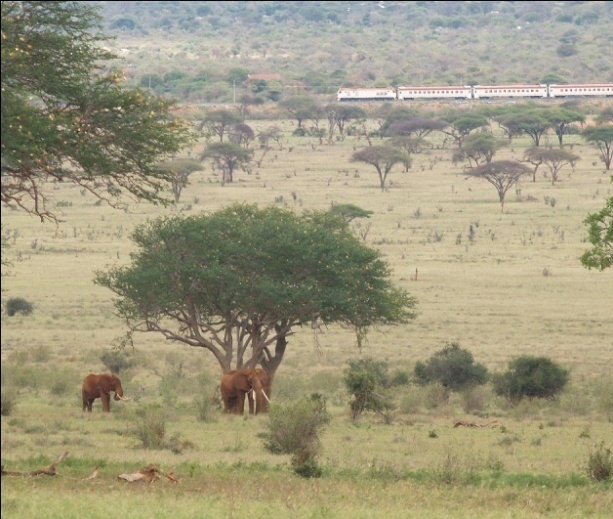
In November, Jarvis (25 years, id-2012), photo left, was with Moonlight (25 years, id-2005) and an unknown bull 20 years, headed toward a waterhole, where many families were aggregating. Jarvis is rarely alone, preferring to be with other bulls, his age or older. Mars (25 years, id-2013) has distinctive tusks; left semi-straight and a shorter right curved tusk. In November, he was with a young bull, 15 years, feeding. When a train passed on the elevated tracks, they moved to the shade of an Acacia, photo right.
Families
Between September and October, most families were comprised of one adult female and her one or two offspring, a typical family structure in Tsavo. In September, a pipe burst from the water pipeline creating a small lake. Many small families traveled from the bush to this water source, joined other small families, drank then the families split and each family would return to the bush in a different direction. Ambrosia and her female calf were near Voi Riverine in early-July. Sixteen days later, they had moved 20 kilometers northwest to Irima. In mid-September, they had moved 12 kilometers north to Mudanda Rock. Many families from the Hill Clan move between these same areas seasonally. Nola’s family and Nutmeg’s family are often together. They were together in May and June, but in November, Nola was alone, without her offspring or Nutmeg’s family, traveling on the road headed to a waterhole where several families were drinking. She had broken off part of her right tusk since the last sighting. She joined a bull for a short time at the waterhole, photo left. After drinking and splashing, she headed north alone, possibly in the direction her family had traveled.
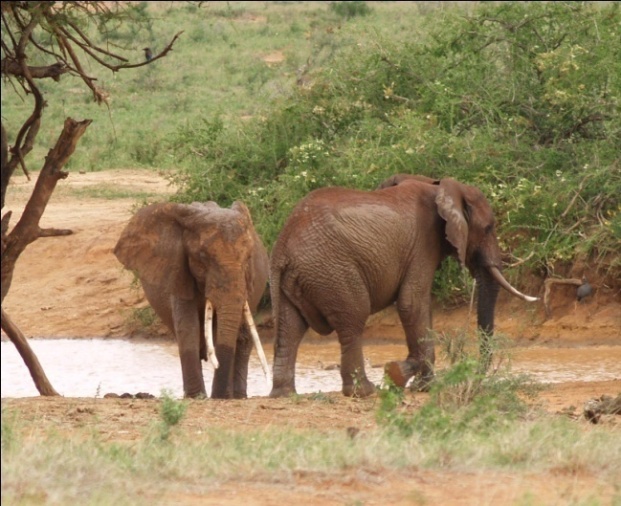
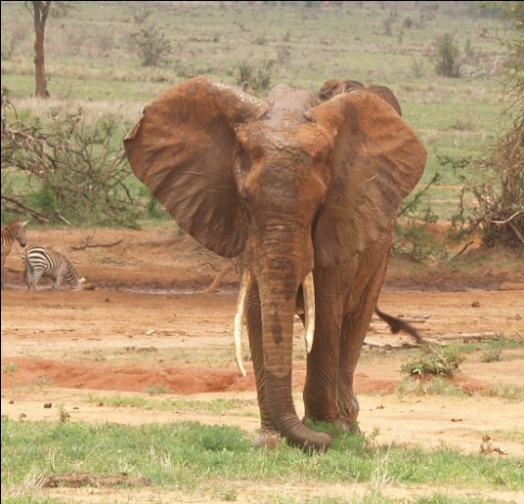
Hazel, photo right, (id-2005) has a distinctive corkscrew shape tail and a notch with a flap on the top of her right ear. She was most often with Holda’s family but over the past two years, they have not been together. In November, she was at a waterhole with her two female offspring, (4-years and 8-years). Like Nola, she had broken off a section of her tusk since the last sighting. Bauhinia’s family, Jarvis and Moonlight were adjacent to the waterhole feeding. When Hazel left the waterhole, she rumbled and Bauhinia answered then headed toward Hazel. Together they moved to another waterhole to drink and splash. Jarvis joined the two families, then as a group, they headed northeast into a thick bush area.
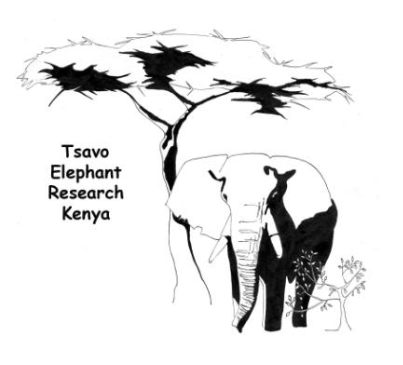
Tsavo Elephant Research Needs Your Help.
Donations are needed to continue this 30+ year field study
and support a Kenyan research field team.
We monitor the behaviors of Tsavo known bulls and families:
group dynamics, offspring & survival, musth cycles and habitat use.
Please click here or on the donate button
to send your donation.
Thank you!
Barbara
